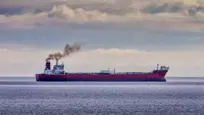
Ship exhaust washed to protect the environment
Waste gas purification with wet scrubbers has proved its worth as an alternative to low-sulphur fuel in shipping companies’ efforts to reduce their environmental impact.
Due to the strict requirements from the UN’s International Maritime Organisation (IMO) aimed at reducing sulphur in ship fuel from 3.5% to 0.5% by 2020, shipping companies must now choose their preferred solution. One of these are so-called wet scrubbers, which make it possible to continue using fuel with high levels of sulphur.
A wet scrubber is installed in the ship’s smokestack and can wash out 98% of the sulphur oxides and 95% of the soot particles. It is particularly beneficial for larger ships with engines from 3 MW upwards to install a scrubber to avoid switching to much more expensive low-sulphur fuel.
Because the exhaust gas is cleaned using large amounts of water that need to be pumped up to the top of the smokestack, electric motor power is crucial for the scrubber’s pumping ability, and Hoyer’s energy-efficient IE3 maritime engines are used increasingly in the powerful pump applications.
Open or closed scrubbers
Alfa Laval is one of the companies that produces wet scrubbers. Jens Peter Hansen, R&D Manager, Exhaust Gas Cleaning, Alfa Laval, explains that a wet scrubber cleans using either an open or closed system, depending on the environmental requirements in the areas where a ship is sailing.
“In the open system, the exhaust gas is cleaned with salt water. Sulphur and soot particles are separated from the gas and dissolved in water, which easily runs up to 1,000 cubic metres of water per hour for a typical ship’s engine. The sulphur gases bind in the water as harmless sulphates, and a large proportion of soot particles are also captured before the cleansing water is returned back to sea,” Jens Peter Hansen explains.
No perfect solutions
As an alternative to the open system, a closed system pumps the same fresh water around via a circulation tank.
“In the closed process, the washed-out sulphur and soot are discharged directly into the sea. Soot particles are collected in a tank and sent to suitable receiving facilities on land, and the sulphur is neutralised in a continuous process using sodium hydroxide. Just a few cubic metres of water containing sodium sulphate are released per hour to prevent sedimentation,” Jens Peter Hansen explains. This is entirely permissible, as the seas already contain large amounts of sodium sulphate.
Both solutions save the atmosphere from dangerous emissions, but no solution is perfect. Whereas the open system sends soot residue out into the world's oceans, the process of cleaning sludge and soot from the closed system would mean extra CO2emissions on land.
An alternative to low-sulphur fuel
Jens Peter Hansen maintains that wet scrubbers are a viable alternative to low-sulphur marine fuel.
“The production of distilled, low-sulphur fuel increases CO2emissions by 10–15%, which makes it more ecofriendly to burn heavy fuel oil directly in the ship's engine and clean the flue gas afterwards instead,” Jens Peter Hansen says.
Facts about IMO and the new sulphur requirements
- IMO (International Maritime Organisation) is an organisation under the UN
- IMO regulates areas such as safety, environment and working conditions
- In 2008, IMO pledged to reduce the sulphur content of marine fuel from 3.5% to 0.5% by 2020
- In special emission control areas, fuel may only contain 0.1% sulphur. These areas are the Baltic Sea, the North Sea and the inner Danish waters, as well as coastal waters around the US and Canada.
- Emission control areas have existed in all Northern European waters and along North American coasts since 1 January 2015.
